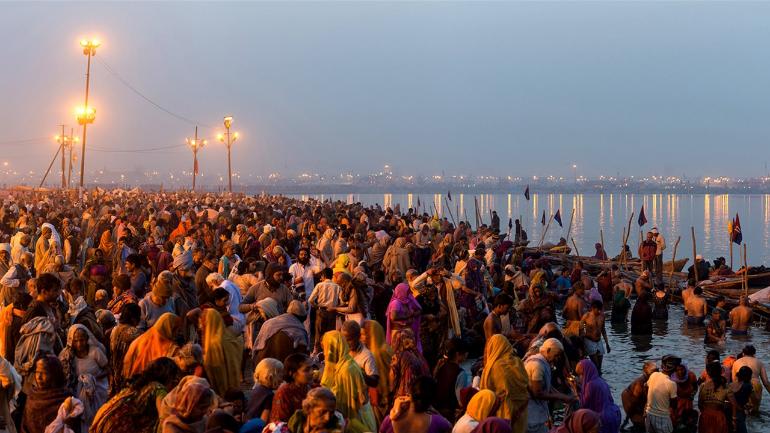Kumbh Mela at Nasik (Maharashtra)
Kumbh Mela is held on the banks of Godavari. The mela is held during the Hindu calendar month of Bhadra (August-September). It is held when Jupiter is placed in Leo or Jupiter, Sun and Moon in Cancer on lunar conjunction. The mela is held after every 12 years.
Nashik-Trimbakeshwar Simhastha is a Hindu religious mela held every 12 years in the Nashik district of Maharashtra, India. The name of the festival is also transliterated as Sinhastha or Singhastha. It is one of the four fairs traditionally recognized as Kumbha Melas, and is also known as Nashik-Trimbak Kumbha Mela or Nashik Kumbha Mela.
The fair involves ritual bathing on the banks of Godavari river, at the Trimbakeshwar Shiva Temple (in Trimbak) and the Ram Kund in Nashik. Until 1789, the fair was held only at Trimbak, but after a clash between Vaishnavites and Saivites, the Maratha Peshwa segregated the Vaishnavites to the Nashik city.
According to Hindu mythology, Vishnu dropped drops of amrita (the drink of immortality) at four places, while transporting it in a kumbha (pot). These four places, including Nashik, are identified as the present-day sites of the Kumbh Mela. The age of the Nashik-Trimbak Simhastha is uncertain, but its association with the kumbha myth is relatively recent, dating back to the 20th century. The Nasik District Gazetteer published during the 19th century does not mention the term “Kumbh Mela” to describe the local Simhastha fair.[1] The earliest extant texts that contain the name “Kumbha Mela” are Khulasat-ut-Tawarikh (1695 CE) and Chahar Gulshan (1789 CE). Both these texts use the term “Kumbh Mela” to describe only the Haridwar Kumbh Mela, although they mention the Simhastha fair at Nashik.
It appears that the Nashik Simhastha adapted the kumbh myth (and the name Kumbh Mela) from the Haridwar Kumbh Mela.The Ujjain Simhastha, in turn, is an adaptation of the Nashik-Trimbak Simhastha: it began in the 18th century, when the Maratha ruler Ranoji Shinde invited ascetics from Nashik to Ujjain for a local festival.
Kumbh Mela is the most important Hindu spiritual gathering in India that comes once every three years, rotating between four major Hindu pilgrim centers of India – Allahabad, Haridwar, Ujjain and Nasik. The Maha (Grand) Kumbh is held every 12th year in each of the following four locations. 2007 Maha Kumbh Mela is scheduled to be held at Nashik in Maharastra.
In Maharashtra, the festival is held in Trimbakeshwar, Nashik. The Nashik Kumbh Mela is generally considered to be the most sacred of all the festivals. Kumb Mela in Nashik, like other fairs is also a mammoth affair attending by nearly three and a half million pilgrims. Thousands of sadhus and holy men and millions of pilgrims take dip in the holy Ramkund and Kushavarta reservoirs.
August 14th and 25th and September 8th and 20th are regarded to be the peak of the festival days. Residential arrangement for Sadhus is made in Tapobhumi called Tapovan on left bank of Godavari river.
Nashik being one of the major cities of Maharashtra, the city is well connected by train, road and air with different parts of India. Accommodation is available at the hotels in Nashik.
Kumbh Mela is held on the banks of Godavari. The mela is held during the Hindu calendar month of Bhadra (August-September). It is held when Jupiter is placed in Leo or Jupiter, Sun and Moon in Cancer on lunar conjunction. The mela is held after every 12 years.
Ramkund is a kund is ghat on river godavari located in Panchavati.It is said that Lord Ram use to have bath in this ghat during his stay in Nasik(panchavati).This ghat has Godavari temple which is opened in 12 years during kumbhamela..it has many other old temples nearby like Narushankar chi ghanta,Kalaram Mandir. many devotees take bath here however the water is not that clean. Asthi visarjan and other Pujas of Hindu custom are done here..
Ramkund is a kund or ghat on river godavari located in Panchavati.This ghat has significant importance in Hindu mythology as Lord Ram is said to have taken bath in this ghat during his stay in Nasik(panchavati).This ghat has Godavari temple which is opened in 12 years during kumbhamela.Other worth watching festivities here are pooja of kapaleshwar mahadeo performed here on Pradosh evening.it has many other old temples nearby like Narushankar chi ghanta,Kalaram Mandir. many devotees take bath here however the water is not that clean.Also asthi visarjan and other ceremonies are being done here and also its believed that even bones get dissolved here.
It is said that when the Jupiter and the sun falls on the zodiac sign, Leo; then Kumbh Mela is celebrated at Trimbakeshwar in Nasik. Kumbh Mela is celebrated with great pomp and show, crowd gets crazy and scenario of the fare is breath taking. Devotees congregate and perform several rites and rituals. Numbers of ceremonies are performed like religious discussions, devotional singing, mass feeding of holy men and women and poor, out of which bathing is considered as most sacred and takes place at the bank of river in every town, where Kumbh is celebrated.


